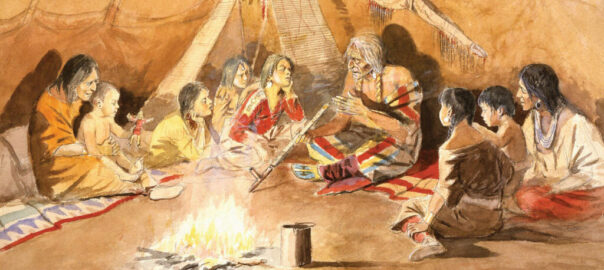
Stories and Storytelling
“Stories are powerful because they transport us into other people’s worlds but in doing that they change the way our brains work, and potentially change our brain chemistry—and that’s what it means to be a social creature.” —Paul J. Zak, The Moral Molecule: How Trust Works
The Evolution of Storytelling

The Evolution of Storytelling
What is it about stories that enables them to work as they do? To understand where stories come from, and why they are crucial to human life, we need to travel back at least 500,000 to long before the birth of our own species.
The World's First Stories
Humanity’s first stories were conceived long ago in prehistory. The earliest were shared by Paleolithic people through cave paintings, carvings of ivory tusks, and engravings etched on stones and shells.
Oral Storytelling
For most of our human history storytelling was oral. Myths were spoken or sung by diverse storytellers who could select and modulate their narrative to best suit a given audience, emphasizing some aspects and ignoring others.
The Written Word
Millenia of dynamic and ever-evolving oral storytelling eventually yielded to the new tool of writing. Text rendered oral traditions and their experience static and fixed in time. A tale, once written down, over time, can become doctrinaire and is believed to be literally true.
Meta-Storytelling
A meta-story conveys overarching insights and a bigger picture beyond the face value tale presented. It connects in a specific way with the storyteller and the audience. The most impactful meta-stories accustom the reader's mind/brain to an alternate consciousness.
The Science of Storytelling
Stories can have a profound effect on us: some scare, some inspire, some move us to nostalgia, sorrow, or action. Angus Fletcher describes a story as “a narrative-emotional technology that helped our ancestors cope with the psychological challenges posed by human biology.”
Teaching Stories

A Unique Form of Literature
“It’s as if we had the unassembled parts of a bicycle, and knew, through analogy (the shapes perhaps) that there was a relationship between the handles and our hands, the pedals and our feet, and so on. We may even have an idea that these are a necessary part of what is known as ‘a bike’ and of ‘riding a bike’ But to actually assemble the bike correctly, and then to be able to ride it, when and where to ride it, that requires contextual thinking: seeing each disparate part as part of a whole. That ‘whole,’ of course, expands with experience and understanding. A comprehensive study of Teaching Stories provides what is for all intents and purposes a limitless whole.” —Robert Ornstein, Teaching-Stories and the Brain, Library of Congress lecture, 2002
The Teaching Story
The Sufis have been using carefully constructed stories for teaching purposes for thousands of years as a means of stimulating and stabilizing an expanded consciousness. Though on the surface these often appear to be little more than entertaining fairytales or folktales, they enshrine—in their characters, plots, and imagery—patterns and relationships that nurture a part of the mind not reachable in more conventional ways, thus increasing our understanding, flexibility, and breadth of vision.
In the series: Ideas that Shaped Our Modern World
- Paleolithic Beginnings
- Connecting with the Gods
- Axial Age Thought
- Jesus: Origins of Christianity
- Muhammad: Origins of Islam
- The Journey of Classical Greek Culture to the West
- A Contemporary Look at the Nature of Religious Experience
- Returning to the Spirit in “Sacred Nature”
- Religious Evolution and the Axial Age
